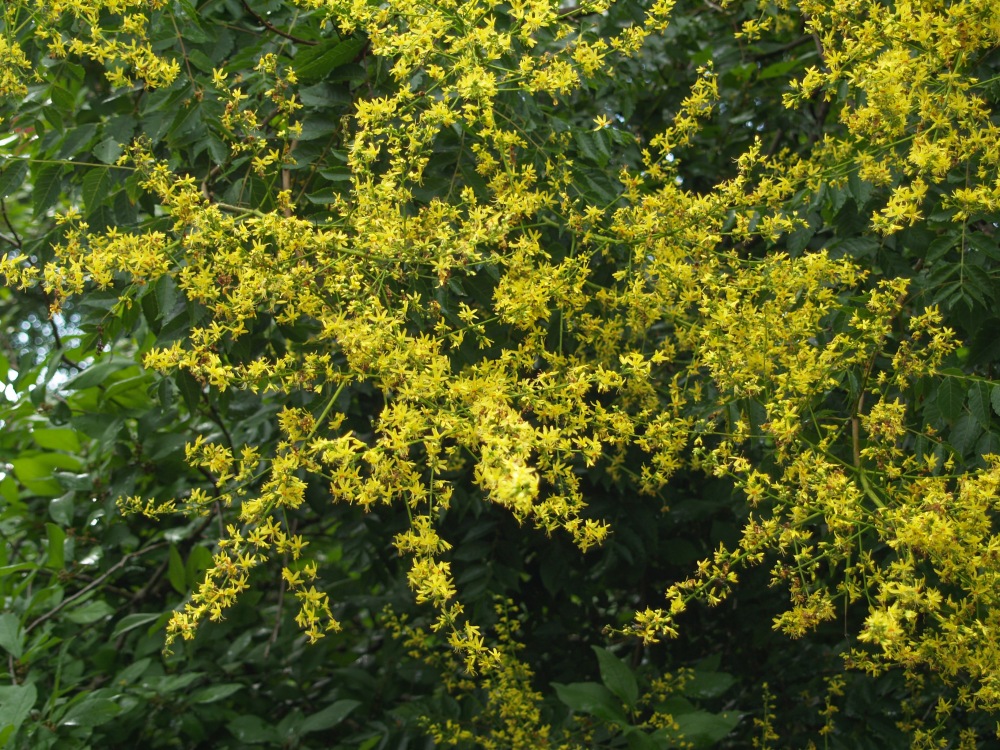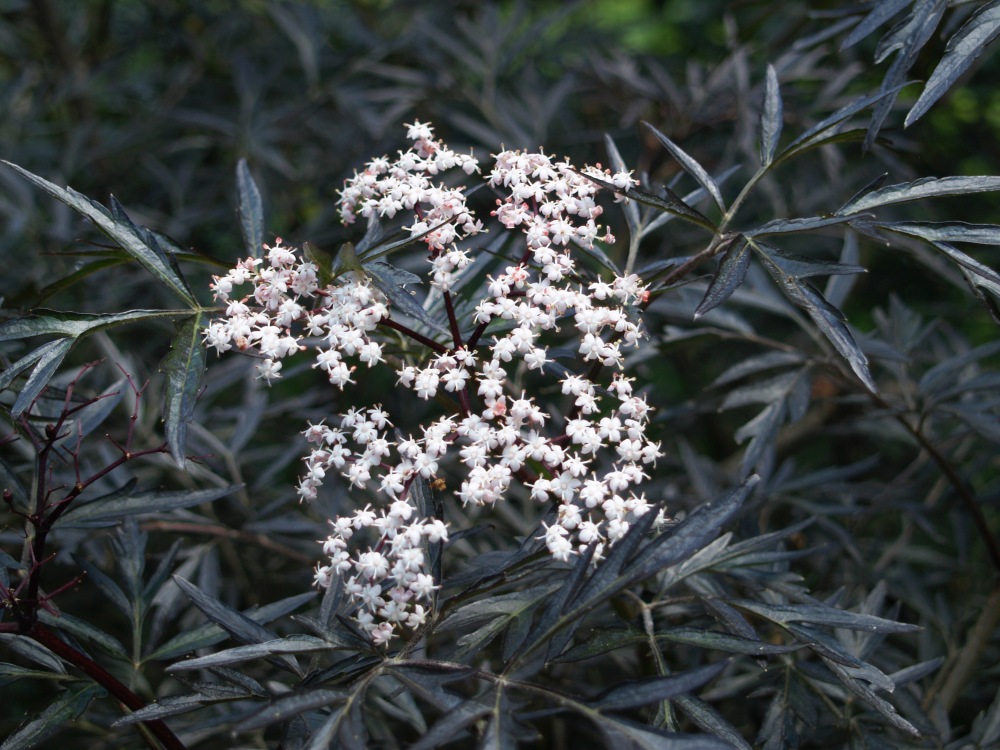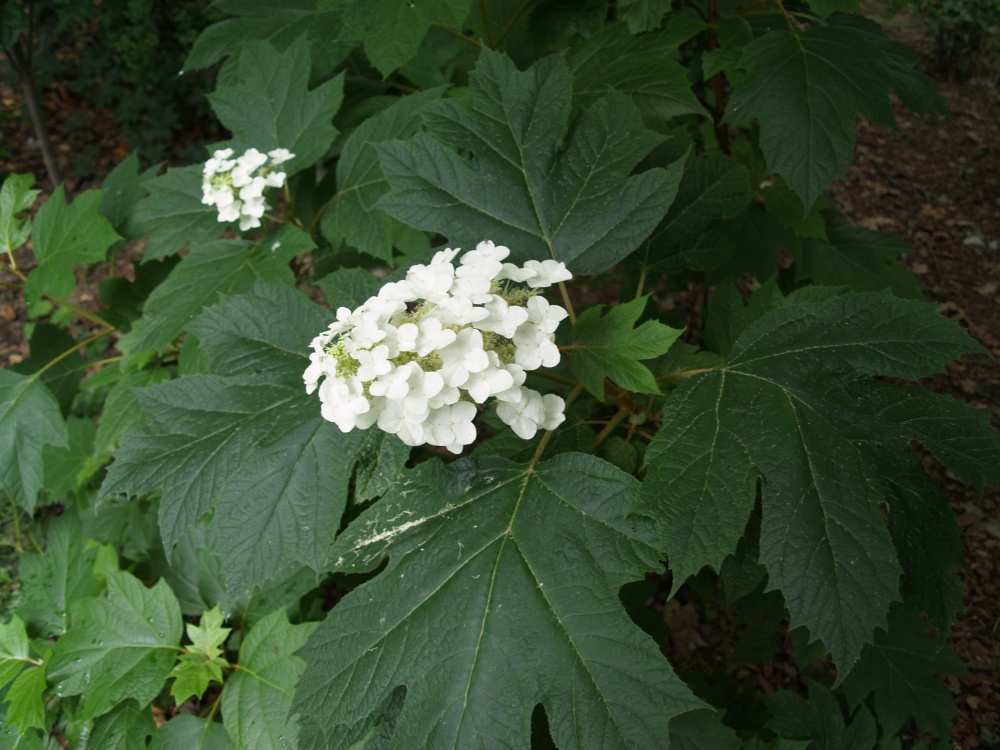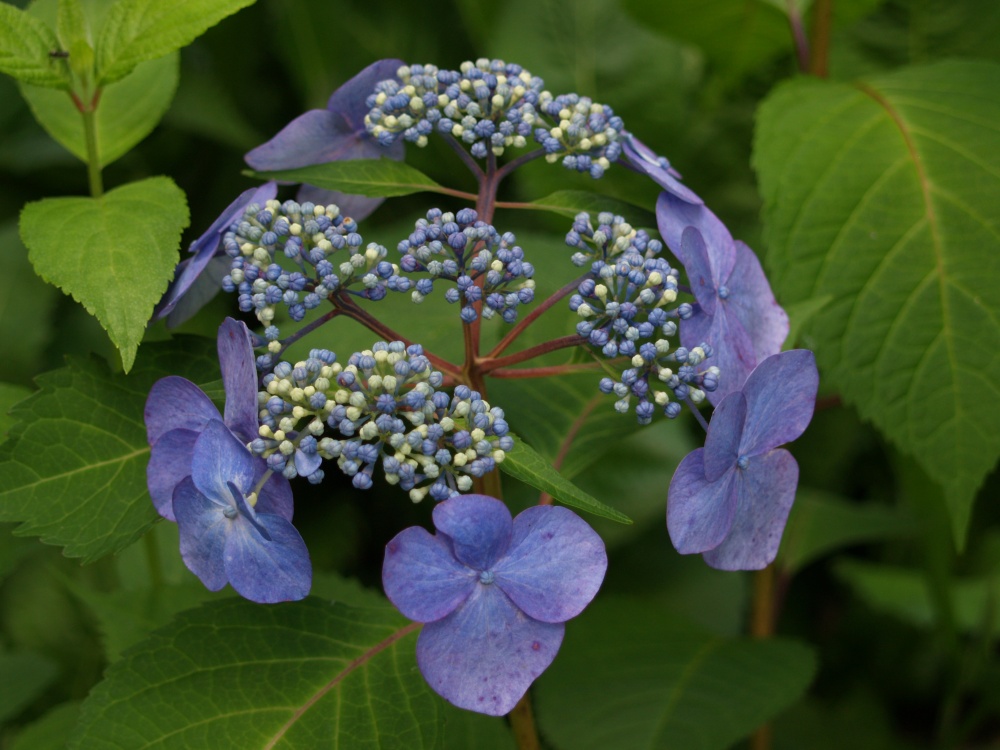Despite my best efforts to spread flowers into other months, there’s no question that the garden’s most abundant blooms are in April and May. In June, instead of the glorious riot of mid spring, the garden is calmer, more sedate, but still flowering profusely, and lush and vibrant before being worn by the heat of summer.
The blooms of Chinese dogwoods (Cornus kousa) and tree lilac (Syringa reticulata ‘Ivory Silk’) slipped away in the first week of June, though in many years their flowers will persist into mid month. Now, Japanese stewartia (Stewartia pseudocamellia, above) and Golden Raintree (Koelreuteria paniculata, below) are the only trees flowering in the garden along with several shrubs, and perennials that will be updated on this page in the next week. The yellow, panicled blooms of golden raintree are showy for ten days before fading, and these are followed by papery seed shells and dark, round seeds that readily germinate to become a considerable nuisance.
I’ve recently warned against planting golden raintree due to my experience with its overabundance of seedlings that must be regularly plucked from every open space within a hundred feet of the tree, and sometimes further. How the seeds are transported, I can’t imagine, though they are round and hard and capable of rolling for a considerable distance. Perhaps birds pick the fallen seeds, then discard them in the farthest spots when they find that they are not so appetizing.
The buds of Japanese stewartia open over several weeks, so there is never a time when the white, yellow centered flowers cover the tree. The stewartia is partially shaded beside one of the garden’s ponds, but this seems not to diminish the number of blooms at all, and certainly the shade does not dissuade bumblebees from buzzing about to gather nectar. Stewartia is prized in the horticulture trade for its late spring flowers and showy autumn foliage color, and though it is slow growing in its early years, it eventually picks up some steam and grows into a fine small tree. Even when stewartia is barely more than a sapling it will flower heavily, and on a tree ten feet tall there will be hundreds of blooms, though never more than a third at one time.
‘Black Lace’ elderberry (Sambucus nigra ‘Eva’, above) began flowering late in May, and several weeks later some blooms remain. The deeply divided foliage of ‘Black Lace’ is the darkest of any purple in the garden, and it’s no wonder that it’s used as a substitute where Japanese maples are not sufficiently cold hardy. By mid summer there are clusters of dark berries, though these are less abundant without a pollinator. I’ve planted ‘Black Lace’ on the back side of my koi pond, where the pond’s pump must be occasionally accessed, and after successfully managing its growth for several years to keep the area open it’s now to the point that it must be left alone or chopped radically. If allowed to grow, the lowest branches will arch over the access point for the pump and over the pond’s edge, which will look wonderful, but will be a bit of pain to crawl under when the pump needs attention.
Only a few feet away, one Oakleaf hydrangea (Hydrangea quercifolia, above) and another across the pond have grown exceptionally this spring, which is usually a good thing, but the new growth has threatened to overwhelm a few of the neighbors. The offending branches were easily pruned out, but this will be a regular chore every spring if all are to live happily side-by-side. I dislike having to keep up with such tasks, mostly because I’m negligent and lazy and smaller plants are too often lost.
Recently, I’ve talked with other gardeners enthused that their hydrangeas are flowering exceptionally well in this late spring, early summer period, and my wife confirms the heavy blooming. I’m not so certain. I think they flower this way every year, but I’m willing to agree just to get along, and there’s certainly no harm in being enthused by an abundance of hydrangea blooms. The mopheads (Hydrangea macrophylla ‘Penny Mac’, above) in particular are at their peak in late June, with little green foliage appearing between the billowing blue flowers.
There have been a few recent hot afternoons when the foliage wilts in the afternoon sun, and for hydrangeas in more sun this will occur frequently over the summer months. At sun down (and after a rain shower) the foliage perks back up, but certainly there is no need to run out for the watering hose every time they droop. When planting hydrangeas they are ideally sited where they will be shaded from the late afternoon sun, but this isn’t always possible and they work out just fine even when they wilt every day for a few months.
I’m not quite as pleased with the blooming of the lacecap hydrangeas as I am with the mopheads. A few seem not like the recent heavy rains, with flowers that are not as well formed as I expect, but this is likely to be my imagination, and I’m sure that it’s not a problem at all. Hydrangeas will typically tolerate moist soils, but one ‘Twist n’ Shout’ (Hydrangea macrophylls ‘Twist n’ Shout ‘, above) has reached the limits of dampness and shows signs of decline. A few other shrubs in this area of the lower garden share similar troubles, and my hope is that as summer progresses the soil will dry and they’ll grow out of it. This happens occasionally, but more often plants cling to life and are killed in a winter freeze.
In the first years after planting I was unhappy with the red stemmed lacecap ‘Lady in Red’ (Hydrangea macrophylla ‘Lady in Red’, above), that bloomed sparsely, and why would I bother with a hydrangea only for red stems and so few flowers? It was heavily promoted, and I’ve grown to be a skeptic that any endorsement from the large branding breeders is likely to be overblown hype. Anyway, ‘Lady in Red’ failed to catch on, and many hydrangeas growers dropped it, just in time for mine to bloom gloriously, so I take back every horrible thing I said about it.
Lots of flowers there. I love the hydrangeas. In Oz it’s winter time so I haven’t seen beautiful flowers like these.
Lovely!